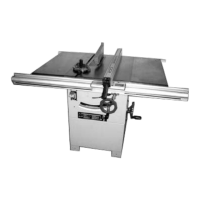3
14. Maintain tools with care
- Keep cutting tools sharp and clean for better and
safer performance.
- Follow instructions for lubricating and changing
accessories.
- Inspect tool cords periodically and if damaged have
them repaired by an authorized service facility.
- Inspect extension cords periodically and replace if
damaged.
- Keep handles dry, clean and free from oil and grease.
15. Disconnect tools
- When not in use, before servicing and when changing
accessories such as blades, bits and cutters,
disconnect tools from the power supply.
16. Remove adjusting keys and wrenches
- Form the habit of checking to see that keys and
adjusting wrenches are removed from the tool before
turning it on.
17. Avoid unintentional starting
- Ensure switch is in “off” position when plugging in.
18. Use outdoor extension leads
- When the tool is used outdoors, use only extension
cords intended for outdoor use and so marked.
19. Stay alert
- Watch what you are doing use common sense and do
not operate the tool when you are tired.
20. Check damaged parts
- Before further use of tool, it should be carefully
checked to determine that it will operate properly and
perform its intended function.
- Check for alignment of moving parts, binding of
moving parts, breakage of parts, mounting and any
other conditions that may affect its operation.
- A guard or other part that is damaged should be
properly repaired or placed by an authorized service
center unless otherwise indicated in this instruction
manual.
- Have defectives switches replaced by an authorized
service center.
- Do not use the tool if the switch does no turn it on and
off.
21. Warning
- The use of any accessory or attachment other than
one recommended in this instruction manual may
present a risk of personal injury.
- Use push-sticks or push blocks to feed the
work-piece past the saw blade.
- Use and correct adjustment of the riving knife.
- Use and correct adjustment of the upper saw blade
guard.
- Rebating or grooving should not be carried out unless
suitable guarding, such as a tunnel guard, is fitted
above the saw table.
- Saws shall not be used for slotting (stopped groove).
- Use only saw blades for which the maximum possible
speed is not less than the maximum spindle speed of
the tool and the tool and the material to be cut.
- When transporting the machine use only
transportation devices and do never use guards for
handling or transportation.
- During transportation the upper part of the saw blade
should be covered; for example by the guard.
- Do not use saw blades which are damaged or
deformed.
- Replace table insert when worn.
- Use only saw blades recommended by the
manufacturer, which conform to EN 847-1.
- Take care that the selection of the saw blades is
suitable for the material to be cut.
- Wear respiratory protection to reduce the risk of
inhalation of harmful dust.
- Saw blades shall be carried in a holder whenever
practicable;
- Connect circular saws to a dust-collecting device
when sawing wood.
- Do not use High speed steel (HS) blades.
- The push-stick or push block should always be stored
with the machine when not in use.

